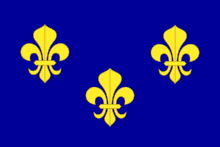Battle of Lunalonge
| Battle of Lunalonge |
|---|
| Part of Hundred Years' War |
| Date | Summer 1349 |
|---|
| Location | Limalonges, Deux-Sèvres |
|---|
| Result |
Draw |
|---|
|
| Belligerents |
|---|
 Kingdom of France Kingdom of France |
English Gascony |
| Commanders and leaders |
|---|
|
Jean de Lille, Seneschal of Poitou[1] |
Thomas Cook, Seneschal of Gascony[2] |
| Strength |
|---|
|
Approx 1500[3] |
Approx 500[4] |
| Casualties and losses |
|---|
|
300 killed plus others captured[5] |
Unknown but all horses lost |
The Battle of Lunalonge was fought in 1349 between Kingdom of France and Anglo-Gascon forces during the first phase (1337–1360) of the Hundred Years' War. The Anglo-Gascons held the upper hand during the day, but had to withdraw on foot during the night because the French had captured their horses. The location of the battle is uncertain but is thought to have been the modern Limalonges in Deux-Sèvres[6]
Preliminaries
The battle was part of a series of raids and actions fought in eastern Gascony in the summer of 1349. In particular, the Seneschal of Poitou, Jean de Lille, had advanced a force to besieged Anglo-Gascon held Lusignan. Thomas Cook, Seneschal of Gascony, led a force of 500 mounted men to the relief of Lusignan but was intercepted at Lunalonge by 1500 French under de Lille.[7] Among the forces on the Anglo-Gascon side was the Captal de Buch, later to be a famous commander, while among the French rode Jean I Le Maingre known as Boucicault, later Marshal of France.[8]
The battle
The French approached the English in three bodies of horse. The Anglo-Gascons withdrew to a small rise in the ground, dismounted and sent their horse to the rear, then formed up holding their lances as spears. The first two French bodies attacked, one frontally, the other circling round the Anglo-Gascons to drive off their horses before charging into the rear. In the course of the fighting, 300 French fell and more were captured, including Boucicault. Eventually the two French units withdrew, leaving the so-far unengaged third group standing watching over the enemy until nightfall, when it too withdrew. The Anglo-Gascons waited for a while then themselves withdrew on foot with their prisoners.[9]
References
- ↑ Tout (1905), p727
- ↑ Sumption(1999), p.49
- ↑ Sumption (1999), p.50
- ↑ Sumption (1999), p.49
- ↑ Sumption (1999), p.50
- ↑ Burne (1991), p.225
- ↑ Sumption (1999), pp.49-50
- ↑ Tout (1905), p.277
- ↑ Sumption (1999), p.50
Bibliography
- Burne, A.H. (1991) [1955]. The Crecy War. London: Greenhill Books. ISBN 1853670812.
- Sumption, Jonathon (1999). Trial by Fire. Faber & Faber. ISBN 0-571-13896-9.
- Tout, T.F. (1905). "Some Neglected Fights Between Crecy and Poitiers". English Historical Review 20: 726–30. doi:10.1093/ehr/xx.lxxx.726.